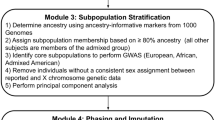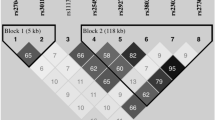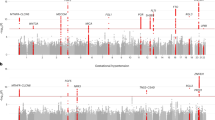Abstract
IGFBP1 plays a critical role in the pathogenesis of preeclampsia (PE), but the association between single nucleotide polymorphism (SNP) of IGFBP1 gene and PE susceptibility has not yet been determined. In our study, 229 women with PE and 361 healthy pregnant (non-PE) women were enrolled to investigate its association via TaqMan genotyping assay. In addition, the protein levels of IGFBP1 under different genotypes were explored by ELISA and IHC. We found that IGFBP1 SNP rs1065780A > G was associated with an decreased risk for PE. Women with GG (P = 0.027) or AG (Padj. = 0.023) genotype manifested a significantly lower risk for PE compared to women with AA genotype. In PE group, women carrying G allele exhibited greater fetal birth weight, lower diastolic BP, and lower levels of ALT and AST. The G genotype was found significantly less frequently in the severe preeclampsia (SPE) group than in the non-PE group (GG vs. AA, P = 0.007; G vs. A, P = 0.006). Additionally, women in the PE group who experienced fetal growth restriction (FGR) reflected a lower level of the allele G than did the non-FGR group (P = 0.032); this was not the case for the non-PE group.Rs1065780A>G elevated IGFBP1 protein level in plasma and decidua in PE group. In conclusion Chinese Han women with the SNP IGFBP1 rs1065780 occupied by G exhibited a lower risk of developing PE relative to women with the A genotype and augured for improved pregnancy outcomes through elevation of IGFBP1 protein level.

This is a preview of subscription content, access via your institution
Access options
Subscribe to this journal
Receive 12 print issues and online access
$259.00 per year
only $21.58 per issue
Buy this article
- Purchase on Springer Link
- Instant access to full article PDF
Prices may be subject to local taxes which are calculated during checkout




Similar content being viewed by others
References
Phipps EA, Thadhani R, Benzing T, Karumanchi SA. Pre-eclampsia: pathogenesis, novel diagnostics and therapies. Nat Rev Nephrol. 2019;15:275–89.
Yang Y, Le Ray I, Zhu J, Zhang J, Hua J, Reilly M. Preeclampsia prevalence, risk factors, and pregnancy outcomes in Sweden and China. JAMA Netw Open. 2021;4:e218401.
Rana S, Lemoine E, Granger JP, Karumanchi SA. Preeclampsia: pathophysiology, challenges, and perspectives. Circ Res. 2019;124:1094–112.
Sitar T, Popowicz GM, Siwanowicz I, Huber R, Holak TA. Structural basis for the inhibition of insulin-like growth factors by insulin-like growth factor-binding proteins. Proc Natl Acad Sci USA. 2006;103:13028–33.
Clemmons DR. Insulin-like growth factor binding proteins and their role in controlling IGF actions. Cytokine Growth Factor Rev. 1997;8:45–62.
Han VK, Bassett N, Walton J, Challis JR. The expression of insulin-like growth factor (IGF) and IGF-binding protein (IGFBP) genes in the human placenta and membranes: evidence for IGF-IGFBP interactions at the feto-maternal interface. J Clin Endocrinol Metab. 1996;81:2680–93.
Hills FA, Elder MG, Chard T, Sullivan MHF. Regulation of human villous trophoblast by insulin-like growth factors and insulin-like growth factor-binding protein-1. J Endocrinol. 2004;183:487–96.
Yu J, Iwashita M, Kudo Y, Takeda Y. Phosphorylated insulin-like growth factor (IGF)-binding protein-1 (IGFBP-1) inhibits while non-phosphorylated IGFBP-1 stimulates IGF-I-induced amino acid uptake by cultured trophoblast cells. Growth Horm IGF Res. 1998;8:65–70.
Li X, Li C, Wang Y, Cai J, Zhao L, Su Z, et al. IGFBP1 inhibits the invasion, migration, and apoptosis of HTR-8/SVneo trophoblast cells in preeclampsia. Hypertens Pregnancy. 2022;41:53–63.
Dunn CL, Kelly RW, Critchley HOD. Decidualization of the human endometrial stromal cell: an enigmatic transformation. Reprod Biomed Online. 2003;7:151–61.
Garrido-Gomez T, Dominguez F, Quiñonero A, Diaz-Gimeno P, Kapidzic M, Gormley M, et al. Defective decidualization during and after severe preeclampsia reveals a possible maternal contribution to the etiology. Proc Natl Acad Sci USA. 2017;114:E8468–E8477.
Gleeson LM, Chakraborty C, McKinnon T, Lala PK. Insulin-like growth factor-binding protein 1 stimulates human trophoblast migration by signaling through alpha 5 beta 1 integrin via mitogen-activated protein Kinase pathway. J Clin Endocrinol Metab. 2001;86:2484–93.
Garrido-Gomez T, Quiñonero A, Dominguez F, Rubert L, Perales A, Hajjar KA, et al. Preeclampsia: a defect in decidualization is associated with deficiency of Annexin A2. Am J Obstet Gynecol. 2020;222:376.e1–376.e17.
Vatten LJ, Nilsen TIL, Juul A, Jeansson S, Jenum PA, Eskild A. Changes in circulating level of IGF-I and IGF-binding protein-1 from the first to second trimester as predictors of preeclampsia. Eur J Endocrinol. 2008;158:101–5.
Liao S, Vickers MH, Taylor RS, Jones B, Fraser M, McCowan LME, et al. Maternal serum IGF-1, IGFBP-1 and 3, and placental growth hormone at 20 weeks’ gestation in pregnancies complicated by preeclampsia. Pregnancy Hypertens. 2017;10:149–54.
van der Kaay D, Deal C, de Kort S, Willemsen R, Leunissen R, Ester W, et al. Insulin-like growth factor-binding protein-1: serum levels, promoter polymorphism, and associations with components of the metabolic syndrome in short subjects born small for gestational age. J Clin Endocrinol Metab. 2009;94:1386–92.
Oh SY, Shin A, Kim S-G, Hwang J-A, Hong SH, Lee Y-S, et al. Relationship between insulin-like growth factor axis gene polymorphisms and clinical outcome in advanced gastric cancer patients treated with FOLFOX. Oncotarget. 2016;7:31204–14.
Fang Z, Yang S, Zhu L, Li Y, Chen Y, Jin Y, et al. Association study of IGFBP1 and IGFBP3 polymorphisms with hypertension and cardio-cerebral vascular diseases in a Chinese Han population. Oncotarget. 2017;8:77836–45.
McGinnis R, Steinthorsdottir V, Williams NO, Thorleifsson G, Shooter S, Hjartardottir S, et al. Variants in the fetal genome near FLT1 are associated with risk of preeclampsia. Nat Genet. 2017;49:1255–60.
Moses EK, Johnson MP, Tømmerdal L, Forsmo S, Curran JE, Abraham LJ, et al. Genetic association of preeclampsia to the inflammatory response gene SEPS1. Am J Obstet Gynecol. 2008;198:336.e331–336.e335.
Metz TD, Nelson LM, Stoddard GJ, Silver RM. FOXP3 gene polymorphisms in preeclampsia. Am J Obstet Gynecol. 2012;206:165.e161–165.e166.
American College of Obstetricians and Gynecologists (ACOG). Gestational Hypertension and Preeclampsia: ACOG Practice Bulletin, Number 222. Obstet Gynecol. 2020;135:e237–e260.
Wang H, Ma L, Pan X, Du Z, Chen Y. Novel associations of SNPs MYLIP rs3757354 and ABCA1 2230806 gene with early-onset-preeclampsia: A case-control candidate genetic study. Pregnancy Hypertens. 2021;23:185–90.
Kakadia JH, Jain BB, Biggar K, Sutherland A, Nygard K, Li C, et al. Hyperphosphorylation of fetal liver IGFBP-1 precedes slowing of fetal growth in nutrient-restricted baboons and may be a mechanism underlying IUGR. Am J Physiol Endocrinol Metab. 2020;319:E614–E628.
Abu Shehab M, Khosravi J, Han VKM, Shilton BH, Gupta MB. Site-specific IGFBP-1 hyper-phosphorylation in fetal growth restriction: clinical and functional relevance. J Proteome Res. 2010;9:1873–81.
Madeleneau D, Buffat C, Mondon F, Grimault H, Rigourd V, Tsatsaris V, et al. Transcriptomic analysis of human placenta in intrauterine growth restriction. Pediatr Res. 2015;77:799–807.
Martín-Estal I, de la Garza RG, Castilla-Cortázar I. Intrauterine Growth Retardation (IUGR) as a Novel Condition of Insulin-Like Growth Factor-1 (IGF-1) Deficiency. Rev Physiol Biochem Pharmacol. 2016;170:1–35.
Giudice LC, Martina NA, Crystal RA, Tazuke S, Druzin M. Insulin-like growth factor binding protein-1 at the maternal-fetal interface and insulin-like growth factor-I, insulin-like growth factor-II, and insulin-like growth factor binding protein-1 in the circulation of women with severe preeclampsia. Am J Obstet Gynecol. 1997;176:751–7.
Larsson A, Palm M, Basu S, Axelsson O. Insulin-like growth factor binding protein-1 (IGFBP-1) during normal pregnancy. Gynecol Endocrinol. 2013;29:129–32.
Christians JK, Gruslin A. Altered levels of insulin-like growth factor binding protein proteases in preeclampsia and intrauterine growth restriction. Prenat Diagn. 2010;30:815–20.
Martina NA, Kim E, Chitkara U, Wathen NC, Chard T, Giudice LC. Gestational age-dependent expression of insulin-like growth factor-binding protein-1 (IGFBP-1) phosphoisoforms in human extraembryonic cavities, maternal serum, and decidua suggests decidua as the primary source of IGFBP-1 in these fluids during early pregnancy. J Clin Endocrinol Metab. 1997;82:1894–8.
Hall K, Hansson U, Lundin G, Luthman M, Persson B, Póvoa G, et al. Serum levels of somatomedins and somatomedin-binding protein in pregnant women with type I or gestational diabetes and their infants. J Clin Endocrinol Metab. 1986;63:1300–6.
Druckmann R, Rohr UD. IGF-1 in gynaecology and obstetrics: update 2002. Maturitas. 2002;41:S65–S83.
Prentice RL, Zhao S, Johnson M, Aragaki A, Hsia J, Jackson RD, et al. Proteomic risk markers for coronary heart disease and stroke: validation and mediation of randomized trial hormone therapy effects on these diseases. Genome Med. 2013;5:112.
Heald AH, Siddals KW, Fraser W, Taylor W, Kaushal K, Morris J, et al. Low circulating levels of insulin-like growth factor binding protein-1 (IGFBP-1) are closely associated with the presence of macrovascular disease and hypertension in type 2 diabetes. Diabetes. 2002;51:2629–36.
Acknowledgements
We thank LetPub (www.letpub.com) for its linguistic assistance during the preparation of this manuscript.
Funding
Guangzhou Science, Technology and Innovation Commission (2019GX03).
Author information
Authors and Affiliations
Contributions
XP and DH conducted the investigation, designation, methodology, data curation, writing (original draft), and writing (review and editing). RP and HX collected the samples and data and assisted in the investigation. JF and DC were responsible for methodology and editing. QL, YG, and JZ collected the samples and data. YC was responsible for resources and supervision. HH was responsible for project administration, resources, and supervision. XP and DH contributed equally to this study. All authors reviewed and approved the final manuscript submitted for publication.
Corresponding authors
Ethics declarations
Conflict of interest
The authors declare no competing interests.
Ethics approval
The present study was approved by the Ethics Committee of the Third Affiliated Hospital of Guangzhou Medical University on 8 August 2014 (REC ref. no.2014 (085)).
Additional information
Publisher’s note Springer Nature remains neutral with regard to jurisdictional claims in published maps and institutional affiliations.
Supplementary information
Rights and permissions
Springer Nature or its licensor (e.g. a society or other partner) holds exclusive rights to this article under a publishing agreement with the author(s) or other rightsholder(s); author self-archiving of the accepted manuscript version of this article is solely governed by the terms of such publishing agreement and applicable law.
About this article
Cite this article
Peng, X., He, D., Peng, R. et al. Associations between IGFBP1 gene polymorphisms and the risk of preeclampsia and fetal growth restriction. Hypertens Res 46, 2070–2084 (2023). https://doi.org/10.1038/s41440-023-01309-8
Received:
Revised:
Accepted:
Published:
Issue Date:
DOI: https://doi.org/10.1038/s41440-023-01309-8
Keywords
This article is cited by
-
Solving preeclampsia from SNP in IGFBP-1 gene
Hypertension Research (2023)



